
It’s a huge mistake.
And yet, I see it happen all the time.
A cannabis industry professional or business owner gets so focused on WHAT they’re training on that they forget to think about WHO they’re teaching it to.
This is the kiss of death for any training program, and sometimes even an entire business.
You could have the greatest training on earth, but if you’re trying to train the wrong person – you’re never going to hit your goals.
That’s why understanding your “Worker Avatar” (AKA persona) is so important.
That’s also why we created the Cannabis Worker Avatar Worksheet (that you can download for FREE), to help you document everything about your “Worker Avatar.”
Before you can train anything effectively, you need to understand…
- Who is your ideal worker is
- HOW they’ll make an impact
- WHAT their challenges are
But how do you do all that? Don’t worry – I’ll dig into the details later on in this post.
First, I want to make sure you understand why “Worker Avatars” are so important, and why I refer to them as the “Swiss Army Knife” of cannabis industry training.
The Swiss Army Knife Of Cannabis Training
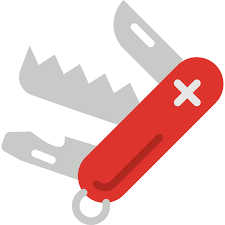 Cannabis training is composed of a lot of different disciplines…
Cannabis training is composed of a lot of different disciplines…
…and for them to be the smartest cannabis experts in the room, a “Cannabis Training Optimization Strategy” makes sense for “Worker Avatars,” right?
In order to be trained to work in the cannabis industry properly, the first thing you must do is get a clear picture on WHO is learning, HOW do they make an impact on their career or in your business, and WHAT their training requirements are…
Developing a cannabis training optimization strategy (in our Instructional Design process we call it “Training Evaluations”) will have a huge impact on professional development in the industry. But HOW?
We’ll get into the how-to in a second, but first, we need to understand who the cannabis industry worker is and ask some questions to optimize their training…
- What are the barriers to training for workers right now?
- Who are the promoters (government, business owners, etc.) of training and worker professional development?
- How competent are workers from their training?
- How satisfied is a cannabis business with their training?
- How many workers need training (yourself or a team)?
This exercise will optimize virtually EVERY aspect of a worker’s training process and/or industry compliance required to get a job and operate legally, including…
- Specialized Training – Do you need customized instruction to meet unique regulatory compliance requirements? We’re in the compliance business, if we do that right, then we’re lucky enough to sell cannabis.
- Industry Certification – What training solutions are workers needing or businesses searching for? If there is proof of extended education, this demonstrates a drive for knowledge and a desire to succeed in the industry.
- Retail Dispensary – What do you need to train dispensary staff on? Topics range from dispensary operations, sales skills, medicinal use, customer relations, and more… all based on best practices.
- Cannabis Cultivation – Does your “Worker Avatar” need to plan on growing cannabis? You need to provide horticultural education to meet the cultivation standards for commercial production.
- Soft Skills Knowledge – Which workers should receive specific soft skills training or not? Soft skills could be aspects of their professional development or could be required social or emotional intelligence.
- Occupational Health – What workers should receive general occupational health training? If they are exposed to any critical hazards affecting health issues, then workers need to safeguard themselves.
- Workplace Safety – Which workers should receive specific workplace safety training? You must take steps to protect everyone in the cannabis industry from all safety issues associated with their work.
…and that’s just scratching the surface. Any part of the industry process that “touches” workers’ training requirements (which is pretty much EVERYTHING) will be optimized when you get clear on your types of workers.
After all, it’s an industry worker that conducts the services and produces the results in business. It pays to get clear on the characteristics of different worker positions, so you can present them with training that moves them to action.
Let’s look at one of our “Worker Avatars” as an example…
(NOTE: Before you can optimize training, you must do is get a clear picture of WHO is learning, HOW they make an impact, and WHAT their professional development requirements are. Download our proven “Cannabis Training Optimization Strategy” now and get clear on what’s needed to learn.)

“Worker Avatar” Example: Meet A Dispensary Technician
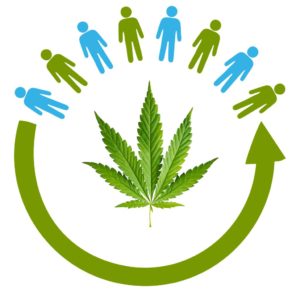 Let’s review more training evaluation questions before we look at some other “Worker Avatars,” but we will focus on the Dispensary Technician (aka “Budtender”) role…
Let’s review more training evaluation questions before we look at some other “Worker Avatars,” but we will focus on the Dispensary Technician (aka “Budtender”) role…
- What topics do workers need to be trained on?
- Is training being recorded (certificates, assessments, etc.)? If it’s not documented, it didn’t happen…
- How much training is there? The number of topics/hours?
- Can you create new training quickly to respond to business needs or emerging regulatory requirements?
Evaluation should be an integral part of each activity in the training development process, including eLearning in its various forms, although many Instructional Designers often overlook it or leave it out!
If you’ve invested resources for yourself via professional development or training for your employees, with all that comes to an expectation to measure its impact.
After all, if you can’t measure IMPACT, you can’t improve it.
The purpose of instructional and training optimization is to provide continuous feedback in order to improve training for our industry worker.
As an example, in 2015, Colorado’s Marijuana Enforcement Division (or MED) created the first-ever compliance training in existence for the world’s cannabis industry – called the “Responsible Vendor Program“ – expected to be completed by all workers in the state.
So, the industry began producing a new type of accredited training: “Specialized Certification.” These types of certifications include required training topics along with exams, certificates, and badges.
A new certification means a new skill for Colorado cannabis industry workers. And, a new required compliance training means a new “Worker Avatar” must be built.
We defined four (4) distinct Colorado “Worker Avatars” below that are impacted by this state-implemented compliance training (that’s expected):
- Dispensary Technician “Job-Seekers” – wants to complete the “Responsible Vendor” training beforehand so they’re employable. In addition, this helps to distinguish themselves from the other applicants competing for the same job.
- “Working” Dispensary Technicians – they’re already employed and working in Colorado’s cannabis industry but need the required “Responsible Vendor” training to maintain their job and to sharpen their skill set.
- The “Cannabis Consultant” – is interested in the state’s compliance training to distinguish themselves from competitors and to be “in compliance” to secure consulting gigs in the Colorado market.
- The “Business Owner” – expected to complete the state compliance training to improve their own expertise and to ensure “best practices” are implemented within their Colorado cannabis business.
As a result, we now have our “WHO” and four (4) new Colorado “Worker Avatars” were born. A couple of these avatars will work as Dispensary Technicians, but ALL workers are expected to complete the “Responsible Vendor” regulatory compliance training.
Let’s focus on our Dispensary Technician avatars working in Colorado, we need to determine what optimization their training requires (more than being “compliant”) …
- How long does it take to get onboarded?
- Is the Colorado compliance training applied?
- What performance area needs improvement?
- What major areas are lacking performance?
- How is learning/training applied to operations?
It’s important to remember that when conducting a training optimization strategy for our Dispensary Technician “Worker Avatars,” it is a systematic process to analyze if training is effective and efficient.
During our training optimization, it will help with the discovery of training gaps and opportunities for developing industry workers. It will collect information that can help determine improvements in training and decide if certain programs should even be discontinued.
![]()
Dispensary owners are always in need of top talent. Let’s have a look at the different components of the Dispensary Technician “Worker Avatar,” as an example.
Members of a dispensary team are the front-line “faces” of the industry, and most of the time, the first person a customer will interact with during the retail experience.
Let’s walk through this “Cannabis Worker Avatar Worksheet,” step by step.
“Worker Avatars” – What To Include
 There are five (5) major components to the “Worker Avatar” strategy that you will need to consider:
There are five (5) major components to the “Worker Avatar” strategy that you will need to consider:
- Goals and Values
- Training and Development Topics
- Demographic Information
- Challenges and Pain Points
- Qualifications and Requirements
In some cases, you’ll have government regulation requirements or need conversations with workers to completely flesh out avatar training needs.
In other cases, you’ll be intimately familiar with the requirements of your ideal “Worker Avatar.”
In any case, move forward.
Don’t wait for surveys or interviews to be conducted to create your avatar draft.
Make assumptions where you have no data or feedback and put it on your short list of to-do’s to complete your research. You’ll benefit from the worksheet to build a “Worker Avatar” from what you know, and IMPACT needed in the cannabis industry, such as…
- Impact on specific worker performance indicators or other development outcomes
- Benefits that can be ascribed a financial value
- The benefits and risks identified
- Overall assessment of the business impact
- Other comments from “Worker Avatars”
Let’s look at sections of the “Worker Avatar” worksheet…
(NOTE: Before you can optimize training, you must get a clear picture on WHO is learning, HOW do they make an impact, and WHAT their professional development requirements are. Download our proven “Cannabis Training Optimization Strategy” now and get clear on what’s needed to learn.)

Goals & Values
![]() We begin with the goals and values of your ideal “Worker Avatar” to determine if they’re a good fit…
We begin with the goals and values of your ideal “Worker Avatar” to determine if they’re a good fit…
Make note of the goals and values that are relevant to the training and professional development you may need.
You’ll use this information to drive training creation, business requirements, and best practices for career development or in your cannabis business (and more).
We know, for example, that an applicant for a Dispensary Technician job is typically interested in “getting their cannabis industry career started.”
As a result, we could draft a training outline for this “Worker Avatar” that promotes the knowledge needed for a Dispensary Technician to succeed in the industry…
What compliance training or professional development is required to be employable and SUCCEED?
That should get all Dispensary Technicians’ attention as you align their personal goals and values into their professional development to execute in their career.
Training & Development Topics
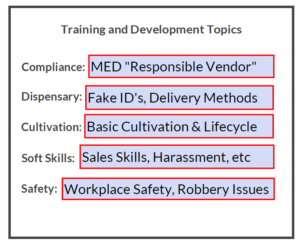 This section of the training optimization strategy is critical to determine “HOW” a Dispensary Technician learns about different aspects of the cannabis industry.
This section of the training optimization strategy is critical to determine “HOW” a Dispensary Technician learns about different aspects of the cannabis industry.
You will determine the best topics to continue training and the targeting development options to educate your “Worker Avatar” by providing sources of great knowledge… so they can continuously make an impact.
Use the “But no one else would” trick when filling out this section of the worksheet. You’ll simply complete sentences like these…
- My ideal “Worker Avatar” would already have completed Colorado’s Marijuana Enforcement Division (or MED) “Responsible Vendor” compliance training.
- My ideal “Worker Avatar” would read cannabis cultivation books, but no one else would.
- My ideal “Worker Avatar” would have safety and health training, but no one else would.
- My ideal “Worker Avatar” would attend cannabis conferences, but no one else would.
Are you getting the picture?
The idea is to find the niche books, magazines, blogs, conferences, gurus, etc. your ideal “Worker Avatar” would be attracted to learn more about the industry – but no one else would spend the time or even exert energy.
For example, if you are training how to determine valid identification (ex. Driver’s License) – you wouldn’t want to only learn Colorado’s Driver’s License (or DL) – since sales can be from people out-of-state (obviously they won’t have a Colorado DL).
Many different types of identification are legal to use that workers need familiar with – just like workers in other legal jurisdictions.
Instead, choosing a more niche training can create compliance risks, you need to hone in on all of the different types of identification your ideal worker needs to know…
When verifying someone’s identification you need to ensure they can legally purchase cannabis, the “Worker Avatar” needs to be able quickly to verify different types of identifications that are perfectly legal to use…
While NOT allowing sales to those who do not have a valid and legal form of identification available.
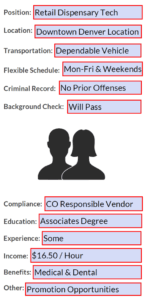 Demographic Information
Demographic Information
Applying demographic information brings your “Worker Avatar” to life.
While demographics are critical, the exercise of filling in these fields is helpful to “identify the minimum requirements” of your ideal worker.
The demographics are another useful part of the “Worker Avatar” to know what’s required to get the job and choosing targeted training options they need to succeed.
Don’t forget to get your “Cannabis Worker Avatar Worksheet” for FREE.
When creating training, reviewing compliance requirements, or other areas of professional development, it can be beneficial to simply write as though your avatar were sitting across the table from you.
Challenges & Pain Points
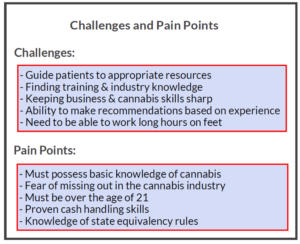 This section drives NEW training topics or professional development. In addition, you’ll identify learning needs you’ll use to compel ideal workers into action to make an impact.
This section drives NEW training topics or professional development. In addition, you’ll identify learning needs you’ll use to compel ideal workers into action to make an impact.
When completing Colorado’s “Responsible Vendor” compliance training for a Dispensary Technician, for example, we would do well to build training to address challenges and pain points and use language that addresses their professional development requirements.
For example, compliance training should include benefits and risks working in the industry like…
Do you want to be fined by cannabis industry regulators, it could hurt your career or employer?
Or…
Are you tired of fearing not doing your job right – because you didn’t get the proper professional development to succeed in your job?
Or…
Do you want to certify yourself and work with certified teams to reduce the risk of being “non-compliant?”
Training like that will get a response from “Worker Avatars” because it is specific to their pain points.
Qualifications & Requirements
 Why would a “Worker Avatar” NOT succeed in the Dispensary Technician role?
Why would a “Worker Avatar” NOT succeed in the Dispensary Technician role?
Do they meet the required experience to qualify or have the necessary requirements for the job?
These minimums must be addressed and met 100% in every business in the cannabis industry.
For example, if we know that a worker does NOT have any experience with out-of-state identifications (or ID) and other team members are be out-of-pocket to ask questions, it might be good to have a resource like…
Identification Checking Guide (ID’s from around the world)
You must also determine your Dispensary Technician’s role in the retail sales process. Are they the primary identification checkers in the retail dispensary?
Understanding your ideal worker’s decision-making process is paramount to the success of their career and any business operating in the cannabis industry.
Build Multiple “Worker Avatars”
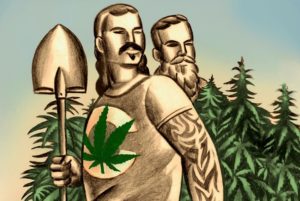 Start by building a single avatar. But don’t stop there. Once you get the hang of it, you’ll be churning out multiple avatars representing the different requirements of the industry jobs essential within a cannabis business.
Start by building a single avatar. But don’t stop there. Once you get the hang of it, you’ll be churning out multiple avatars representing the different requirements of the industry jobs essential within a cannabis business.
Don’t go overboard, but any cannabis industry “Worker Avatar” with a distinct set of training, compliance requirements, professional development, etc. is deserving of having an avatar built for their training optimization.
Training optimization is an important process to determine the effectiveness and check if training is indeed helping individuals become good at what they do.
Through strategic evaluation, you can find ways to improve the quality of training and achieve the goals set for employee success.
Use the “Cannabis Worker Avatar Worksheet” below to get clear on your ideal training needs and if implemented properly, you will get a return on your investment:
- Training Costs and Financial Benefits
- Return-on-Investment (or ROI) Percentage
- Benefit-to-Cost Ratio
- Payback Period
![]()
Click the Image to Download and Fill in Your Worker Avatar!
Armed with the knowledge in this resource, you’re ready to put it to work for your career or business! But why stop here? There’s so much to learn about cannabis…
If you’re looking to kick it up a notch and become a better cannabis expert, you need systems and training that…
- Consider the broader lessons from your training optimization strategy and list recommendations based on the findings. Recommendations should identify what should be maintained or expanded, and where changes to training and development seem necessary.
- Also, consider the impact of the costs and benefits of training Return-on-Investment (or ROI).
Let us know what you think.




Responses